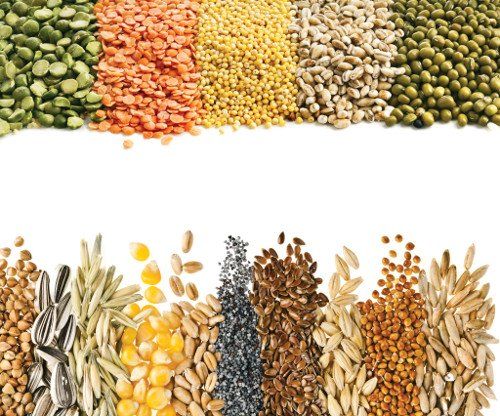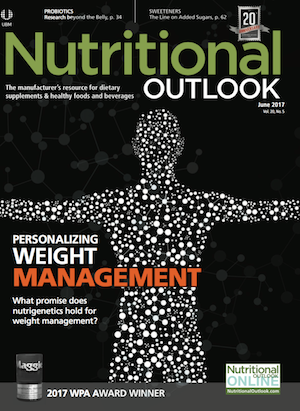2017 Plant Protein Ingredient Update
Plant protein is unstoppable, with more options at formulators’ fingertips than ever before.
Photo © Shutterstock.com/Madlen

In 2013, the 68th UN General Assembly declared that 2016 would be the International Year of Pulses (IYP 2016). And boy, did they call that one. The global pea-protein market alone was set to surpass 12,598.2 MT in volume with a value north of $34.4 million in 2016, per Future Market Insights (FMI) data. And looking ahead, FMI says the pea-protein sector should expand at a CAGR upwards of 11.8% in value and 12.0% in volume as we move toward 2026.
So even as 2016 recedes into the rearview mirror, there’s scant reason to believe that IYP’s time is up. Or, as Jon Getzinger, chief marketing officer, World Food Processing (Minneapolis), says, “It’s probably wise not to crystal-ball this too much, but let’s just say that the year of the pulse is turning into the decade of the pulse.”
Yet even that may be too limiting a view of the coming wave. For when you take into account that the global value of the plant-protein market writ large may hit $10 billion and a CAGR of 5.7% by 2020, according to Mordor Intelligence data, the near future might better be called the golden age of plant proteins, period-with room for pulse, soy, wheat, and even algae to establish beachheads. As Getzinger says, “It would certainly appear that this isn’t a short-term trend.” With ingredient options improving dramatically, “The use of plant proteins will continue to gain support among all types of consumers,” he says.
Planet Plant
Plant-derived or not, protein isn’t slowing down. A raft of factors keep it humming, including an increasing global population, rising incomes-“which tend to correlate with increased protein consumption,” says Amanda Donohue-Hansen, business development manager, Cargill (Minneapolis)-and a keen awareness of protein’s health benefits. Each is “leading consumers to incorporate more protein into their diets,” she says.
Fortunately for the planet and its inhabitants, plant-based options are increasingly their choices. Notes Neelesh Varde, PhD, senior product manager, Roquette (Geneva, IL), the task of feeding the two billion additional people projected to occupy the planet 30 years from now will put “tremendous strain” on its natural resources. “Since animal-based proteins require much more land and water to produce than do plant-based proteins,” he says, “we’ll have to shift to more plant-based options globally.”
Consumers are getting the message, and the growing ranks of “flexitarians” are leading the shift. As recently as 10 years ago, Varde notes, those flexitarians were dismissed “as vegetarians who cheated or lacked willpower to stick to a purely veggie diet.” Now, he says, they outnumber American vegetarians by more than three-to-one. Their diet, which makes room for both animal and plant protein, “offers a nice alternative for those who want to embrace health but not give up entirely on meat consumption.”
And that embrace of health cannot be discounted as a factor nudging consumers toward plant proteins.
Notes Alan Rillorta, marketing director, AIDP (City of Industry, CA), “People hear that plant protein is ‘good for me’ and jump onboard.” For good reason: “Adding more plant protein to the diet is good for people,” he says. “Fiber, additional nutrients, a smaller carbon footprint, and lower costs are all drivers.”
Yes, Peas!
As is the current crop of plant-based proteins, the quality and palatability of which leave its predecessors in the dust. “More options in the plant-based market have emerged,” says Julia Linhart, assistant marketing manager, Cyanotech Corp. (Kailua-Kona, HI), “and that gives consumers more choices that weren’t there before.” Even better, she adds, “Plant-based proteins can taste really good!”
Donohue-Hansen agrees. “Plant proteins continue to improve as producers refine their processing conditions to minimize ‘off’ flavors.” In addition, she says, “by leveraging flavor maskers and through formulation expertise, we’re able to further mask off flavors in the final product.”
Pea protein-premier among pulses-is a principal beneficiary of these improvements. Though “there are vast organoleptic differences among manufacturers,” Getzinger says, “with profiles ranging from incredibly smooth and clean to something akin to a fresh-mown field, the bar is moving up on many plant proteins, and especially pea.”
Varde is bullish on pea, as well. By his reckoning, the raw ingredient doesn’t require fertilizer and actually fixes nitrogen into the soil; and peas “are among the stingiest in their need for land and water compared to other pulses and cereals,” he adds. On the nutrition side, pea protein has a relatively high PDCAAS (protein digestibility-corrected amino acid score) and “has been shown to produce similar results1 to whey in terms of muscle growth,” he notes.
Even its functionality is a draw, suiting it to a wide variety of applications. Pea “can be extruded into a cereal crisp for use in snacks or nutrition bars, or into a textured meat alternative,” Varde says. “It works well in beverage applications, both RTD and powdered drink mixes. It can function in gluten-free baking mixes or in spreads like peanut butter.” All told, he says, “it makes sense for formulators and consumers alike.”
Give Wheat a Chance
So, too, does wheat protein-which, despite the reputational beating it’s suffered at the hands of gluten-phobes, remains a go-to protein for effective formulation. True, formulators serving a celiac, hypoallergenic, or reflexively anti-gluten market won’t find much use for wheat protein. But product developers not bound by those limits will find it plenty useful, indeed.
After all, says Ody Maningat, PhD, vice president and chief science officer, MGP Ingredients Inc. (Atchison, KS), functional and physicochemical properties are the top attribute that developers look for in proteins-and here, wheat protein has an advantage. Wheat gluten, he says, is “the only plant-based protein capable of exhibiting the unique elasticity and extensibility properties-or viscoelasticity-that are crucial in breads and other bakery products.”
His company makes wheat protein isolates that span the viscoelastic spectrum, with options ranging from those displaying less extensibility (e.g., able to serve as dough strengtheners) to more-extensible proteins fitting the needs of tortillas, pizza crusts, and flatbreads. Textured wheat proteins are classic choices in vegetarian meat analogues, he adds, “and dominate other textured-protein sources in terms of taste and texture.” Their granules, chips, and shreds can be colored to match different animal protein sources and “take on a meat-like appearance and resilient fibrous texture when hydrated,” he says. When unhydrated, they can top sweet goods like cookies or serve as crunchy, protein-dense components in nutritional and protein bars.
And in ready-to-drink protein beverages, Maningat says, lightly hydrolyzed wheat proteins stand out for their water solubility and protein quality-delivering about two times the peptide-bonded glutamine concentration of soy or whey. That gives wheat protein an edge in reducing muscle soreness and in aiding muscle recovery post-exercise, Maningat says, citing Kansas State University research. Moreover, lightly hydrolyzed wheat proteins are functional, too, reducing mixing times in flour-based doughs.
In with the New
There’s something deliciously “old school” about wheat proteins, which-like soy and rice-have never truly left the scene. But with wheat, soy, rice, and even pea nearing or even reaching their “saturation points,” says Rikka Cornelia, product manager, BI Nutraceuticals (Long Beach, CA), alternative plant proteins like fava bean, lentil, and pumpkinseed “are on the upswing.”
Rillorta adds sacha inchi, hempseed, and cranberry seed proteins to that list. He notes that with brands “looking for ways to give their protein formulations a complete nutrition profile from a variety of sources rather than relying on just pea and rice,” including such up-and-coming options “allows for a way to stand apart from other formulations on the shelf.”
Donohue-Hansen has “definitely” noticed some customers “investing in and seeking unique proteins largely for their novelty and ability to differentiate their products from competitors on the shelf.” In other cases, “the formulator or marketing department is targeting protein claims and fortification, which will require selecting proteins with the best nutritional profile.”
Cecilia Wittbjer, vice president of marketing, Parabel (Melbourne, FL), points to her company’s concentrated water-lentil protein as just such an ingredient. It’s higher in essential and branched-chain amino acids than other plant proteins, she notes, which should be “interesting for formulators.” And with minimal processing taking it from harvest to finished ingredient in 40 minutes, it’s “definitely a farm-to-table product.”
Another minimally processed plant protein, and one that’s squarely on the cutting edge of plant sources, is spirulina, a microscopic blue-green algae. Cyanotech has been cultivating a select strain of this tiny plant, Spirulina platensis, for decades and markets it as a protein source providing 2 g of protein per 3-g serving. “Once the spirulina is ready for harvest,” says Gerry Cysewski, PhD, Cyanotech’s CEO and founder, “we send it to be washed with high-pressure fresh water, then to our unique Ocean Chill Dryer, and finally to be turned into a powder or tablet. The whole process from pond to powder takes only 30 minutes and uses no chemical processes. It’s about as clean and pure as you can get for a protein source.”
“Clean and pure” certainly scores points with plant-protein partisans. But there’s a “very real technical motivation to minimize processing of proteins,” Donohue-Hansen notes. Too much can damage the proteins, she says, “adversely impacting their nutritional and functional properties. Finding the right milling, heat, pressure, time, and drying conditions is critical to extracting the plant’s inherent functional and nutritional properties.”
Of course, that’s easier said than done, Cornelia concedes, “especially when it comes to plant-based protein concentrates, which require some processing to concentrate the protein to a useful level.” Her solution: “Switching from a harsher solvent like hexane to water or ethanol can sometimes ‘clean up’ the process and make it more consumer friendly.”
Putting Protein to Work
Those aren’t the only tips that protein experts have for optimizing plant-based formulations. Bill Gilbert, certified master baker and principal food technologist at Cargill, notes that when proteins hydrate, they compete for water, “increasing the density of puffed cereals, snacks, and baked products.” Years of experience with varying protein sources have given his team a deep understanding of their water-absorption rates, enabling them to “keep the rheology the same so that formulators don’t have to dramatically change the amount of water in their formulas,” he says.
Beyond water management, he notes that proteins can inhibit a dough’s development, “making it stiff and difficult to stretch and sheet, and causing headaches on the production line.” And some plant options still have “unique” flavors that confound efforts to mask, he says. In these cases, “finding the right blend is the real key.”
Cornelia also sees flavor as “the biggest issue” with plant proteins. “Picking a good source with a mild, clean flavor-like fava bean protein-is a great starting point,” she says. “But a good flavor system is paramount, too.” And when it comes to texture, she says that “it’s often helpful to incorporate a fiber or stabilizer to help with mouthfeel” when proteins turn finished products thick, chalky, or powdery-which they sometimes do.
The upshot: “Even the best plant proteins aren’t drag-and-drop solutions,” Varde concludes. “Formulators have to consider the matrix in which the protein’s entering and understand the nutrition and functionality it’s expected to deliver. In a powdered drink mix, you’d need to consider dispersibility and solubility. In RTD, you’d have to look at viscosity increase over time. How do other ingredients affect these parameters? And remember: what works on the benchtop may not work on the plant scale, so there’s a lot of science and craft going into producing a final product.”
Also read:2017 Ingredient Trends to Watch for Food, Drinks, and Dietary Supplements: Plant Protein vs. Dairy ProteinSports-Nutrition Formulators Eye Opportunities, Challenges of Plant Proteins
References:
- Babault N et al., “Pea proteins oral supplementation promotes muscle thickness gains during resistance training: a double-blind, randomized, placebo-controlled clinical trial vs. whey protein,” Journal of the International Society of Sports Nutrition, vol. 21, no. 1 (January 21, 2015): 3


.png&w=3840&q=75)

.png&w=3840&q=75)



.png&w=3840&q=75)



.png&w=3840&q=75)


















